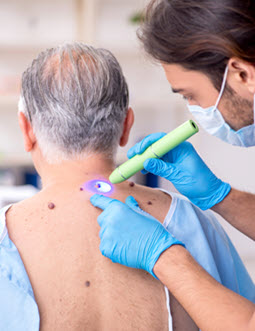Schedule a certified mohs surgery expert for precise and effective skin cancer removal.
Schedule a certified mohs surgery expert for precise and effective skin cancer removal.
Blog Article
Navigating Skin Cancer Cells Treatment: The Necessary Function of Mohs in Modern Dermatology Practices
Skin cancer cells, a difficult diagnosis, commonly leaves clients grappling with numerous treatment choices. Amongst these, Mohs surgical procedure stands as a sign in modern-day dermatology, renowned for its meticulous approach to cancer elimination and conservation of bordering healthy and balanced tissue. This cutting-edge practice guarantees not only remarkable cosmetic end results however likewise uses prompt outcomes, reducing patient stress and anxiety. As we explore the intricacies of this treatment, one will certainly value its essential duty in skin cancer treatment.
Understanding Skin Cancer Cells: Kinds and Risks
Skin cancer, a potentially deadly malady, is much more prevalent than lots of people understand. This illness, triggered by the unrestrained growth of abnormal skin cells, largely arises from DNA damages due to direct exposure to the sunlight and ultraviolet (UV) light. There are 3 main kinds of skin cancer cells: Basic cell carcinoma, Squamous cell cancer, and Cancer malignancy. While the former 2 are much less deadly and comprise the majority of diagnosed cases, cancer malignancy is one of the most hazardous. It represents only about 1% of skin cancer cells situations yet creates the substantial majority of skin cancer cells fatalities - skin cancer. Risk factors consist of reasonable skin, history of sunburn, excessive sun exposure, living at high elevations or near the equator, having several moles, a family background of skin cancer, and compromised body immune system.
What Is Mohs Surgical treatment and Exactly How It's Changing Skin Cancer Cells Treatment
In spite of the many treatments currently available for skin cancer, Mohs surgical treatment attracts attention as a groundbreaking and extremely effective service. Named after Frederic E. Mohs, the physician that established the procedure, Mohs surgery is an accurate surgical method used to deal with skin cancer cells. During the treatment, slim layers of cancer-containing skin are considerably gotten rid of and examined up until just cancer-free cells stays. This technique allows the specialist to verify that all cancer cells have been eliminated at the time of surgical treatment. This level of precision, combined with navigate to this website the capacity to save as much healthy tissue as feasible, is transforming skin cancer cells therapy. Consequently, Mohs surgical procedure has actually ended up being a keystone of contemporary dermatology methods.
The Benefits of Mohs Surgery Over Typical Skin Cancer Cells Therapies
Building on the ingenious nature of Mohs surgical procedure, it's crucial to consider its countless advantages over standard skin cancer therapies. Unlike basic treatments, Mohs uses a higher treatment rate, commonly getting to 99% for new therapies and 94% for reoccurring cancers. Furthermore, it minimizes damages to healthy and balanced skin, leading to much less scarring and improved cosmetic end results.
The Treatment of Mohs Surgical Procedure: What to Expect During the Refine

Prospective Negative Effects and Post-Operative Treatment of Mohs Surgical Procedure
Going through Mohs surgical treatment, like any kind of other surgery, entails potential side effects that clients should recognize. Typical negative effects consist of discomfort, wounding, and swelling at the surgical procedure site. Nonetheless, these are typically short-term and workable with over the counter discomfort medication and ice bag. In rare cases, people may experience infection, blood loss, or an allergy to the anesthetic. Post-operative care is critical to recovery and decreasing adverse effects. visit the site This commonly entails keeping the injury clean and dry, taking recommended medicines, and preventing difficult tasks. Individuals ought to additionally participate in more information all follow-up visits for injury care and tracking. In some situations, added treatments may be required to make sure full removal of the cancerous cells. Sticking to these post-operative care standards can considerably improve recovery and outcomes.
Verdict

Report this page